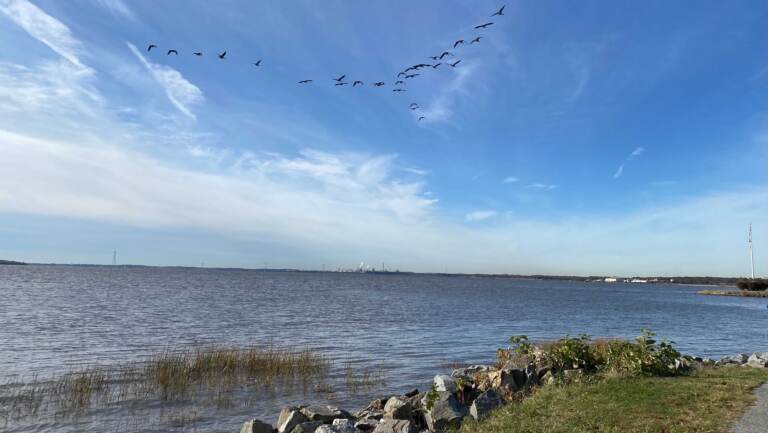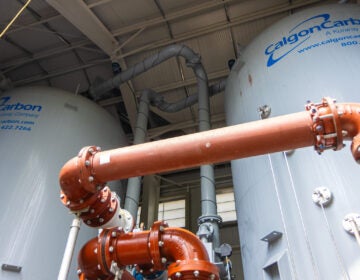EPA pushes for more pollution controls in the Delaware River to protect endangered Atlantic sturgeon
Only about 250 endangered Atlantic sturgeon are left in the Delaware River. Pollution has reduced oxygen levels to the point where the sturgeon struggle to breathe and breed.

The Delaware River near New Castle, Del. (Mark Eichmann/WHYY)
Environmentalists are cheering a surprising win for the Atlantic Sturgeon, an endangered fish native to the Delaware River that was once so plentiful it spawned a caviar rush.
The Environmental Protection Agency this week called for improved water quality in the Delaware Estuary to protect fish, including the sturgeon. Threatened by dams, lack of oxygen, by-catch, and strikes from large ships, there are only 250 sturgeon left in the Delaware River.
Environmental groups, including the Delaware Riverkeeper Network, petitioned the EPA under the Clean Water Act to implement standards that would ensure there’s enough dissolved oxygen in the Delaware Estuary for Atlantic Sturgeon to survive and grow its population. The agency agreed that current oxygen levels do not suffice, and that water quality standards for aquatic life for a portion of the Delaware River Estuary must be revised.
The granting of this kind of petition is extremely rare, said the Riverkeeper’s Maya Van Rossum, who has been advocating for the sturgeon’s protection for 30 years.
“We were not anticipating that we were going to have this petition granted,” she said. “So when the decision came down, I really was ecstatic. I was very, very happy, because I know that this is what needs to happen if we want to have a prayer of preventing our genetically unique line of Atlantic sturgeon from disappearing from the face of the Earth forever.”
Fish rely on a certain amount of oxygen in the water to thrive and survive. Current oxygen levels in the Delaware Estuary are only half the amount necessary to support the spawning and growth of Atlantic sturgeon. The reduced oxygen levels are caused by pollution from wastewater facilities’ discharges and other sources.
The activists have been calling on the Delaware River Basin Commission, a multi-state agency that oversees water quality in the entire watershed, to implement stronger dissolved oxygen standards. That would have led to more stringent requirements for both industrial and wastewater facilities to reduce polluted discharges into waterways.
In a statement, the DRBC called the petition by the environmentalists “unnecessary,” arguing that the agency has already been working to address oxygen levels in the water. For the past five years, the regulatory agency has been studying dissolved oxygen and related pollution. The agency has found that oxygen levels were most impacted by ammonia, and have been researching ways to reduce it.
The DRBC also said the EPA’s move could hamper its own process.
“While EPA’s decision has the potential to create a duplicative regulatory process, the DRBC is committed to continuing to work jointly with EPA and state co-regulator agencies in Delaware, New Jersey, and Pennsylvania to develop water quality standards using sound science to meet the goals of the Clean Water Act and the Delaware River Basin Comprehensive Plan,” the agency wrote in a statement.
Environmentalists have accused DRBC of dragging its feet, and argued that the agency’s study focused too much on economic feasibility of pollution controls rather than oxygen levels needed for sturgeon to survive.
The EPAs’ decision speeds up the regulatory process, committing to proposing a new clean water standard within a 12-month period.
“They understand the time sensitivity of this, and getting a standard in place that quickly, really does give us a chance of addressing this problem in a [timeframe] that’s going to make a difference for the surgeon,” Van Rossum said.
WHYY is your source for fact-based, in-depth journalism and information. As a nonprofit organization, we rely on financial support from readers like you. Please give today.






